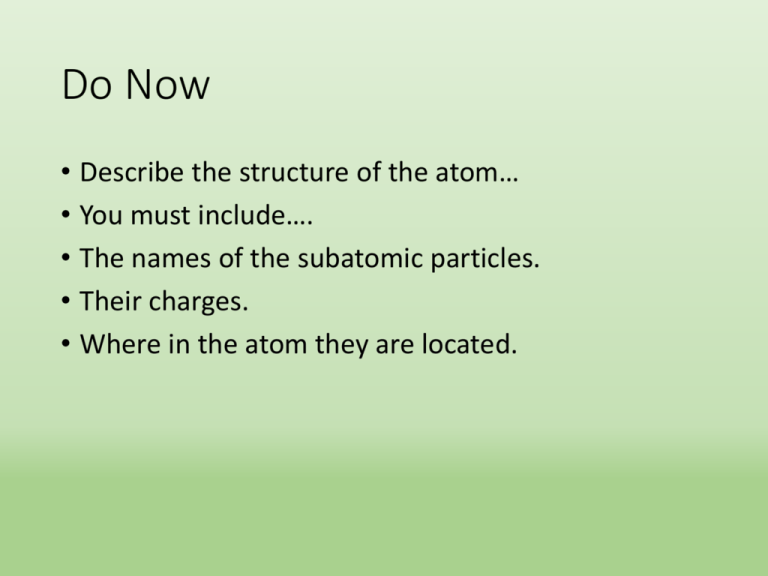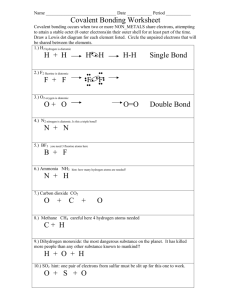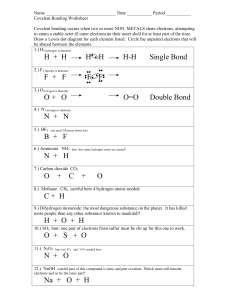Covalent Bonding
advertisement

Do Now • Describe the structure of the atom… • You must include…. • The names of the subatomic particles. • Their charges. • Where in the atom they are located. Atomic Structure • Protons- Positively charged particles located in the nucleus • Neutrons- Uncharged particles located inside the nucleus • Electrons- Negatively charged particles located outside the nucleus Comparing subatomic particles… particle symbol electron e- relative mass (amu) 1/1840 proton p+ 1 neutron n0 1 Green – metals Yellow – nonmetals Blue - metalloids Atomic Number • # of protons • # of electrons in a NEUTRAL atom • Always a whole number Mass Number • # of protons + neutrons • in atomic mass units (amu) • Isotopes - atoms of the same element with different masses • differ in number of neutrons • Examples: Carbon-13 & Carbon-14 Do Now • Draw Lewis dot structures for Nitrogen, Calcium, Sulfur, and Potassium. • Give the oxidation numbers for Sodium, Iodine, Phosphorus, Barium, Aluminum, and Oxygen. • Give the formula for the compound formed between Magnesium and Nitrogen. Oxidation Number • - The charge that the ion gets when it either loses or gains electrons is called the oxidation number. The sum of the oxidation numbers for the atoms in a compound must be zero In order for a compound to exist, it must be electrically neutral ‘Criss - Cross’ Method The formula for the The formula for the compound composed compound composed of potassium and of calcium and sulphur bromine K 1+ & S 2- This becomes K2S Ca 2+ & Br 1- This becomes CaBr2 Steps to follow • Step 1- write element symbols with the metal first • Step 2- write the oxidation numbers next to the elements • Metals = valence electron number (with a (+) sign) • Nonmetals = -(8-valence electron #) • Step 3- criss-cross numbers without signs • Step 4- don’t write 1’s for final compound • Step 5- Reduce the numbers Welcome Back!!! Do Now Group Period 2 4 17 5 13 4 6 6 Element Name Element Symbol P (+) N (0) E (-) Do now • Q2Z is the formula of an ionic compound made from non-existant elements. • Which element is a non metal? • What are the oxidation numbers for each element? • How many valance electrons does each element have? • Draw a dot structure for each element. Counting Atoms in a Compound • Subscripts- small number next to an element • Example: Al₂ O₃ 1 compound: Al₂O₃ 2 elements: Al and O 5 atoms : 2 aluminum and 3 oxygen atoms Compounds with parentheses • Multiply the number outside the parentheses by all of the subscripts inside • Example: • Ga₂ (SO₄)₃ • Ga = 2 , S = 1x3 = 3 , O = 4x3 = 12 Find the number of atoms for each element in the following compounds: • AgNO3 • • Al(ClO3)3 • • (NH4)2SO3 DO NOW • What is the difference between a physical change and a chemical change? Chemical Reaction • A reaction happens when two or more molecules interact and the molecules change. • A chemical change must occur. You start with one compound and turn it into another. Chemical Equations • Their Job: Depict the kind of reactants and products and their relative amounts in a reaction. 4 Al (s) + 3 O2 (g) ---> 2 Al2O3 (s) • The numbers in the front are called coefficients Chemical Equations • All chemical equations have reactants and products. • We express a chemical equation as follows: Reactants Products • The arrow is equivalent to an “=“ math. When we describe the equation we use the word “yields” or “produces” instead of equals • Example C + O2 CO2 • This reads “carbon plus oxygen react to yield carbon dioxide” Chemical Equations A. _______________ B. _______________ C. _______________ D. _____________ E. _____________ F. _____________ Subscripts vs. Coefficients • The subscripts tell you how many atoms of a particular element are in a compound. The coefficient tells you about the quantity, or number, of molecules of the compound. 2Mg + O₂ 2MgO What are the reactants in the equation above? • Mg and O • What are the products in the equation above? • MgO •2 Do now • Explain why coefficients are needed in a chemical equation. Balancing Chemical Equations Because of the law of the conservation of matter (matter can not be created or destroyed) an equation must be balanced. It must have the same number of atoms of the same kind on both sides. Balance this equation! Na + Cl2 Na-1 Cl-2 NaCl Na-1 Cl-1 **note that the number of sodium atoms balance but the chlorine does not. We will have to use coefficients in order to balance this equation. Do Now • Balance this equation • ____ N2 + ____ F2 ____ NF3 Try this one • ____ Na3PO4 + ____ KOH ____ NaOH + ____ K3PO4 Do Now • Describe some pieces of evidence that would indicate a chemical reaction has taken place. Types of Reactions: Single Replacement A + BC Zn + 2HCl 2Al + 3CuCl2 B + AC H2 + ZnCl2 3Cu + 2AlCl3 Types of Reactions: Double Replacement AB + CD Ag(NO3) + NaCl 2Ag(NO3) + K2(CrO4) AD + CB AgCl + Na(NO3) Ag2(CrO4) + 2K(NO3) Types of Reactions: Decomposition AB C12H22O11 A + B 12C + 11H2O Types of Reactions: Synthesis A+B 2Mg + O2 AB 2 MgO Endothermic/exothermic Reactions • A reaction that releases heat as it happens is called Exothermic. • A reaction that absorbs heat is called Endothermic. • An Endothermic reaction feels cold (because it is absorbing your heat) • An Exothermic reaction feels hot. (because it is giving off heat) Exit Card: Name Each Reaction DO NOW • Define an endothermic and exothermic reaction • A reaction that absorbs heat is called endothermic. • A reaction that releases heat is called exothermic. • An Endothermic reaction feels cold (because it is absorbing your heat) • An Exothermic reaction feels hot. (because it is giving off heat) Do Now: • Describe the difference between an ionic and a covalent bond Covalent Bonds • A bond between two nonmetals. • Electrons are shared instead of transferred to make the compound stable. ex: H + H H2 Covalent Bonding • Remember that ionic compounds transfer electrons in order to attain a noble gas electron configuration Covalent compounds form by sharing electrons to attain a noble gas electron configuration Regardless of the type of bond, the Octet Rule still must be obeyed (8 valence electrons) Single Covalent Bond • A Single Covalent Bond consists of two atoms held together by sharing 1 pair of electrons (2 e-) Electron Dot Structure Shared versus Unshared Electrons • A Shared Pair is a pair of valence electrons that is shared between atoms An Unshared Pair is a pair of valence electrons that is not shared between atoms Double Covalent Bonds Sometimes atoms attain noble gas configuration by sharing 2 or 3 pairs of electrons • A Double Covalent Bond is a bond that involves 2 shared pairs of electrons (4 e-) Triple Covalent Bond • A Triple Covalent Bond is a bond that involves 3 shared pairs of electrons (6 e-) Covalent Bonds Do Now • Define the rule of octet • State how many bonds each atom can form • Oxygen, Sulfur, Nitrogen, Carbon, Chlorine, Phosphors, Hydrogen, Fluorine, (hint) draw dot structures) Naming Guidelines – PBr5 • Name of first element (phosphorus) • Prefix needed if more than one atom • Name of second element (Bromine) • Prefix needed, even if 1 (mono) • Root name plus –ide (pentabromide) • PBr5 is phosphorus pentabromide Possible Prefixes • • • • • • • • • • One Two Three Four Five Six Seven Eight Nine Ten is is is is is is is is is is MonoDiTriTetraPentaHexaHeptaOctaNonaDeca- Name Covalent Compounds • CO • CO2 • SO2 • SO4 • SF6 • NI3 • P2O5 • CCl4 Carbon monoxide Carbon dioxide Sulfur dioxide Sulfur tetraoxide Sulfur hexafluoride Nitrogen triiodide Diphosphorus pentoxide Carbon tetrachloride






